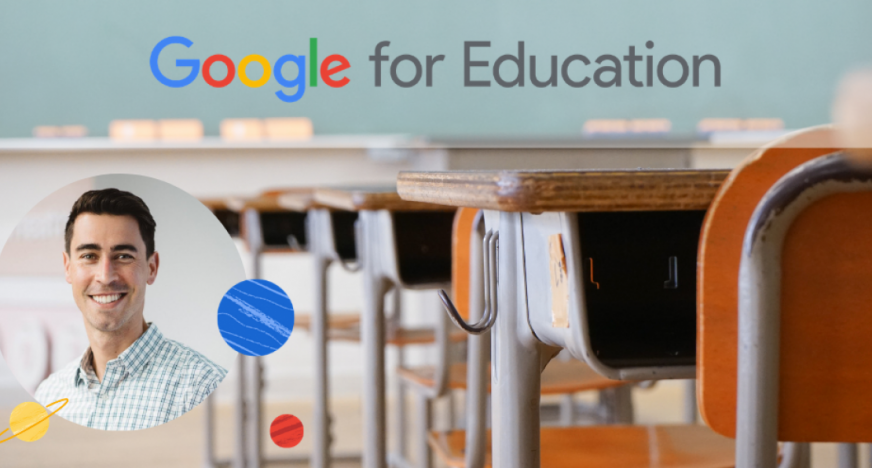Transforming Education with Cloud Technology: An Interview with Googler James Leonard

With the current state of the world in the middle of a pandemic, the education space has been under the microscope as institutions across the globe have had to transform their traditional teaching methods to a digital platform. The overhaul of taking a physical, in-person practice for students of all ages and converting that into a remote and hybrid solution has been an undertaking, to say the least. There is a light at the end of the tunnel - the whole educational system has been dissected and improved to allow for a more flexible and powerful way to educate.
To dive deeper into this topic, we sat down with James Leonard, Google’s Global Channel Lead for Google Workspace for Education. James started at Google back in 2013 at the Mountain View office in California before taking his expertise across the pond in London, helping Europe transform their education technology. Now, he’s back in the States leading the charge for the Google Workspace for Education platform. But, before joining Google’s team eight years ago, James was a teacher on the frontlines of education in the classroom. Who better to tackle the challenges of the traditional classroom with an educational focus for the Google for Education platform than a teacher?
What is it like at Google?
"Google is more of an idea than a place right now, of course. I’ve been at Google now for eight years, and seven of those have been going into a physical office, whether that be earlier in my career at Mountain View, at headquarters, or more recently at the London office, where I was for four and a half years leading our Education practice there. In many ways, a big part of the identity of being a Googler is going to the office and experiencing the perks, the food, and the people. I think when we all moved remote, you obviously miss out on the physical aspect of being at Google, having that sort of sense of company culture around you physically. But, in my function, I’ve been able to still feel like I’m really connected to the company because of the people. I’m sure all of us feel that in a certain way - that even though we’re physically distant, you still identify with the people of a place. So, things are great!
I’m working with a lot of great colleagues around the world in this function for Workspace for Education - colleagues that I’ve worked with years ago in my role in North America and internationally. It’s been quite the year for Google for Education. Now more than ever, there’s been a lens on the way in which we provide tools and solutions for schools across the company. That has provided a lot of opportunities and the team has really risen to the challenge. Things are good at Google!”
Tell us a little about your journey with Google for Education? How did you get to this point, what was it like this past year?
“Well, my overall journey started in 2013. I joined the Google for Education team a couple years removed from the classroom as a teacher and joined when we were just starting to sell Chromebooks into the US schools. From that point forward, it’s been an incredible journey. We saw the mass adoption of devices. We saw the ascension of Google for Education, namely Chromebooks, to really being a leader by 2015. In 2016, I decided to embark on a different challenge and hopped a plane across the pond to the UK where technology adoption was still lagging a bit. I spent four and a half years there building up the team, our go-to-market practice, and our partners’ capacity to facilitate G-Suite for Education then (currently known as Google Workspace for Education) and Chromebooks. I got antsy for a new challenge in late 2020, and I saw Workspace for Education and our paid editions as the next frontier of the Google for Education business.
It was an immense opportunity for our partners, who to date, hadn’t had a paid software offering from Google to take to market. I coupled my sense of the opportunity with my experience and skills working with partners and education customers and made a jump for this new opportunity leading the Google Workspace for Education channel. The last year has been a watershed moment for educational technology overall, and our Workspace for Education products specifically. We’ve seen not only usage of the free versions absolutely skyrocket, new users coming on in countries all across the world that had to digitize overnight, and also a mass conversion from free to paid as customers relied on infrastructure like Google Workspace for Education for schooling, creating some semblance of a classroom. They had a point in the past where they maybe hadn’t paid Google for software, and they saw the value in the premium products we were offering. Helping Resellers respond to that moment has been a real pleasure in the last six months or so, in this new role.”
Walk us through the evolution of Google for Education and the newly branded Google Workspace for Education. Why rebrand?
“The rebrand has happened for a couple of reasons. At its most basic level, the Google for Education team was about four to five months behind the broader rebrand to Google Workspace on the commercial side. As Workspace rebranded in October 2020, there was a lot going on in education at that time. So, we pushed the rebrand to February of 2021. We also integrated changes to our SKU lineup to our editions. Previously, we had an all or nothing approach with our paid software - it was either a free version or everything in a product called G-Suite Enterprise for Education. With the new change in branding, we also added new editions. We broke that G-Suite Enterprise for Education edition into a couple of onramp editions. So, there are now three versions of premium Google Workspace for Education software products. There’s [the] Education Standard and the Teaching and Learning upgrade, which are mid-tiered SKUs. Education Standard provides more security-focused tools while Teaching and Learning provides more teaching and learning focused tools, like video conferencing and plagiarism detection. The catch-all, premium product, Google Workspace for Education Plus, provides schools the access to both security and teaching and learning premium functionality.”
Transforming education is at the heart of what Google is doing. Can you tell us more about this? Not every child learns the same way. How is Google supporting differentiated instruction?
“I think about this a lot. I think our role as a platform company is to build a platform, provide training, and facilitate an ecosystem of partners that will take both of those pieces and help schools with the implementation. What we focus on is making a platform that is available anytime, anywhere, is flexible, and can be taken by a user and transformed for a particular student’s needs. And also building based on the needs of our users. One example in terms of differentiated instruction are all of the changes that have come to Google Meet since the early days of the pandemic. You look at the product a year ago and it looks completely different now. Differentiation comes to mind when I think of a feature like Breakout Rooms that we added to Google Meet all of maybe four or five months ago. So, we’re constantly listening to our users and adding functionality that will allow students to have more individualized experiences with their instructor, even if it’s digitally like the Breakout Rooms functionality.”
Equity in education is a goal everyone in education can get behind. But it’s not always easy to define precisely what we mean when we talk about equity. Is it about outcomes? Resources? Funding? Academic support? How is Google defining equity in education and what are you doing to help close the gap?
“I think it’s all of the above - I think it starts with a product company ensuring that from an accessibility perspective, from a cultural perspective, users have an equal access point to using the product. So, you think of something like Google Classroom. Google Classroom, as we were building it back in 2014-2015, was tested in schools from Pre-K to university. There are a lot of tools out there in the LMS space that I wouldn’t necessarily want a 4-year-old to use, and others that a 21-year-old might not use. Just looking at usability as an equalizer in terms of access is a really important place to start in terms of ensuring equity. So, we try to think about building for all when we build any product. From a broad support of equity and education, we also believe that training is incredibly important. It’s not enough to just build a platform - it’s about providing schools with access to free online training anytime anywhere that can help them do more with that tool. So, we are constantly developing training resources that will help schools get the most out of the platform, whether they’re a Google Workspace for Education Fundamentals customer (free) or a paying customer.”
So, you’re working towards providing every student and teacher with personalized and powerful learning environments. What will Google Workspace for Education bring to the table that really makes it stand out?
“I’d say that within our ethos of Google Workspace for Education, we’ve gone through this evolution of formally just getting really what businesses were getting with it then: Google Apps, then G-Suite, and now Workspace product. So, Classroom was the first example of a tool within the Workspace for Education product suite that was built for education specifically, directly based on the feedback of educators. That tool set the standard for how we would approach other tools and the way that we were building for those tools. So, you look at something like Google Forms and Google Meet - for both, the majority of users globally are actually EDU users, even though they’re part of the broader Workspace subset. Something like Quizzes in Google Forms, or even something as simple as a feature we rolled out a couple months ago that allows teachers and students to save their form drafts - so if you’re filling out an essay on Google Forms, you can come back to it if you lose an internet connection. I think that ethos of benefiting from this broader tool set of Workspace products, but also having a very specific education lens on products that are used primarily by educators - Forms, Google Sites, Classroom - you get this sort of blend of the best of both worlds. You have the broader infrastructure of Google building for Fortune 500 companies to make Workspace the best product it can be, and then also teams within Google for Education building out the functionality of classroom-specific tools. Of course, with the paid editions, there’s additionally more powerful and bespoke functionality, both from a security perspective and from a teaching and learning perspective.”
Flexibility, simplicity, and security are the crucial elements most institutions are looking for. How can you be everything to every institution?
“I think you’re never going to be everything to every institution because every institution is coming from a legacy of technology and a legacy of technology investment, especially in education. You may have systems that have been in place for quite a while. But, as more and more institutions rely on cloud-based Software-as-a-Service, namely Google Workspace for Education, we know that we need to provide ways to mitigate and also anticipate threats. The key thing about security and security threats is that threats are not reactionary.
Threats are proactive. There are always bad actors that are not looking back and reading the Security Threat Almanac from 2018 about how to do a phishing attack or how to penetrate a vulnerable piece of software. They’re hacking and they’re at the bleeding end. So, there’s a number of ways in which we look at that. One is just looking at security as defense and depth, especially schools and institutions that have invested in Google infrastructure - Workspace for Education, Chrome OS, [etc]. There’s a benefit from a sense of uniformity across the stack and less points of failure. When we look at the Google Workspace for Education security proposition, a lot of it is both in the Education Plus and Education Standard editions, and there are tools within those editions that allow you to mitigate existing threats, a threat that has happened, but more importantly, anticipate threats that may be coming.
There’s one really valuable tool called Security Health Dashboard that will act as sort of a Security Coach across your Workspace for Education domain and say, ‘Here’s how many users in your organization don’t have two-factor authentication turned on,’ or ‘Here’s how many users in your organization have shared drive files externally that maybe you want to try and lock down.’ The great thing is that there are breadcrumbs to go and actually action those items. There won’t ever be one solution that will completely button up their entire security posture, but certainly as more schools have moved the majority of the ways that they’re working to a platform like Workspace, the tools within our premium security SKUs allow schools to get a better sense of what’s happening and what’s ahead.”
What is Google doing to prevent some of the smart hackers that might be part of the educational community in the way of students looking to cheat on assignments and exams, or outsmart the system?
“Our community of IT Administrators looks for holes in the system, and there’s always best practices in terms of an initial setup for Workspace for Education domain that can help prevent misuse and abuse. Within the Workspace Admin Console, there are ways to restrict access to certain capabilities. For example, you may not want to give your students the ability to create a Google Classroom class - you may just want to reserve that for teachers. And you can get as granular as you’d like for a number of key features. We provide the platform and best practices, and then we have partners who provide consulting services and a very active community of IT Administrators that are often eager to share best practices on those types of topics. Education is really interesting, because there are seldom as many competitive forces across schools. You get a lot more sharing of best practices than you would on the commercial side.”
What’s next for Google Workspace for Education? How are you planning to supercharge classes and inspire learning?
“I think there’s a lot more that you can expect from the team in terms of analytics. For Workspace for Education paid users, we’re providing some kind of templated dashboards that will provide schools with more insight in terms of what’s been going on within Google Classroom, more analytics related to posts and usage across the organization. I think analytics is an area that you’ll continue to see us there more from an administrative side. Other than that, we’ll just continue to follow user feedback. Our product roadmap is actually generated from user feedback. We’ll continue to supercharge learning based on what teachers want us to supercharge. We don’t want to go out there and build a bunch of functionality that isn’t going to be useful. So, we’ll continue to follow our North Star, which is really looking at what educators are asking for. Any teacher or administrator can submit feedback directly in Google Classroom, for example, and we’ll continue to create features that follow that roadmap. We get tons of feedback and our product team reads every single bit of feedback that is submitted through some of the in-product feedback mechanisms.”
If a kid walked up to you asking for your advice and you only had a few minutes to give them your best tip, what would it be?
"Never underestimate the power of strong oral and written communication, and really investing, as a kid and a student, in your own style of writing. Especially being in the working world in a knowledge economy, no matter what you’re writing - whether you’re writing a product specification or you’re a salesperson writing a compelling email to a prospective customer, being able to communicate effectively both orally and in written form is a lifelong skill. It’s recognized when it isn’t there. I’m a former English teacher, so maybe that impacts my answer. I do think that written communication has staying power. As digital as we’ve gone, the power of the written word is still the way in which we process information and make judgments based on what we read and what others write. In the educational context, investing time as a student and really honing in on one’s ability to write clearly and concisely is just as important as it ever was.”
What do you like to read? Any good educational blogs you would recommend?
“The educational blog that I’ve come back to for years now is one called https://www.edsurge.com/, which is a great view of the industry as well. They keep a pulse on mergers, acquisitions, movers and shakers, new rounds of funding, etc. It’s a really good way to have a sense of what’s important in ed tech at the present moment.”
Speaking of education, what is one thing you wish you had access to while you were getting your education?
“I’ve seen some examples that now make me wish I had that experience. One is bilingual immersion. When I was teaching, I taught at a dual immersion program, a K-8 program, and I taught English. I was one of the few people who wasn’t bilingual. All of my students were bilingual and biliterate. I just see the power and the gift in bilingual education and what it did for students whose native language was Spanish learning those core, foundational skills of multiplication and division in a native language and experiencing English socially and through the curriculum as well. And also for those students whose native language was English being exposed academically to Spanish at an early age and kind of having that ability to absorb it while the mind is still really malleable for language learning and how quickly students caught on. I was constantly jealous of my students’ bilingualism.
I also think the movement for STEM and STEAM education in the last five years has really been interesting to watch. The rise of Maker Spaces and the Maker Movement certainly points back to the importance of education funding for these auxiliary programs. I really feel for parents, students, and teachers right now who maybe haven’t necessarily had the ability to be in a physical classroom like a Maker Space or part of a program in the last year that has fostered that sort of tinkering and hands-on learning. I’m hopeful that everyone can get back into those spaces soon. Certainly, I’ve found myself, even just at children’s museums with my little ones, kind of just losing myself in some of the activities. I’ve wondered when I’ll get to go back to a Maker Space. They actually have a couple at Google, so maybe I’ll add that onto my post-pandemic list of things to do - spend more time with a 3D printer.”
For further information on Google for Education and how to become a reseller with Ingram Micro Cloud https://www.ingrammicrocloud.com/google-cloud/.
-
Category Company & Partnership News, Platform & Product Updates
-
Written by Transforming Education with Cloud Technology: An Interview with Googler James Leonard
-
Published on May 14, 2021






























